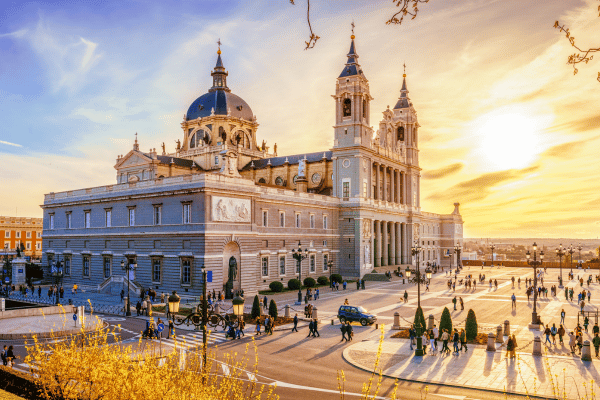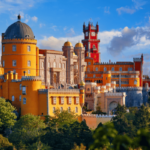Embarking on the journey of comparing Barcelona and Madrid is like opening a treasure chest of cultural, culinary, and architectural gems. Both cities boast their unique charms, attracting travelers worldwide. Yet, as we dive into the “Barcelona vs. Madrid travel” experience, we uncover distinct vibes, histories, and attractions that make each city a world of its own.
Introduction: Embarking on a Tale of Two Cities

Stepping into Barcelona, one is immediately swept up by its vibrant energy. The city’s streets are a canvas painted with Gaudí’s whimsical architecture and the lively buzz of the Ramblas. Every corner tells a story, inviting explorers to lose themselves in its enchanting maze. It’s a place where history and modernity dance together under the Mediterranean sun.
Transitioning to Madrid, the change in ambiance is palpable. The Spanish capital exudes a regal air, with its grand boulevards and stately museums. Here, tradition and sophistication intertwine, offering a different kind of allure. Madrid’s essence resides in its plazas, where locals and visitors converge, sharing tales and laughter amidst historical figures’ gaze.
When discussing “Barcelona vs. Madrid travel,” it’s not about declaring a winner. Instead, it’s about celebrating the contrasts that make each city unique. Barcelona’s beachside serenity complements Madrid’s cosmopolitan hustle. Both destinations offer a kaleidoscope of experiences, ensuring that every traveler finds their rhythm. It’s a journey of discovery, where the true essence of Spain is revealed in its diversity.
Cultural Showdown: Barcelona’s Modernist Art vs. Madrid’s Royal Heritage
Barcelona’s streets are a living museum of modernist art, where each building and park whispers tales of creativity and innovation. The city’s soul is deeply intertwined with the works of Antoni Gaudí, whose masterpieces, like the Sagrada Familia, paint the skyline with their unique forms. This artistic fervor invites visitors to delve into a world where imagination takes physical shape, offering a feast for the senses.
In contrast, Madrid’s cultural tapestry is woven with threads of regal elegance and classical beauty. The city’s royal palaces and historic sites stand as testaments to Spain’s rich heritage. The Prado Museum, home to some of the world’s most revered artworks, offers a journey through time. Here, the splendor of Spain’s monarchic past is displayed in every hall and gallery, connecting the present with the grandeur of bygone eras.
The “Barcelona vs. Madrid travel” experience is enriched by this cultural duel. While Barcelona captivates with its avant-garde spirit, Madrid embraces travelers with its aristocratic grace. Both cities, though distinct in their offerings, are united in their ability to inspire awe and appreciation for the arts. The choice between them becomes not one of preference but of what kind of beauty one wishes to explore next.
Culinary Delights: Tapas in Madrid and Paella in Barcelona
Madrid’s culinary scene is a vibrant mosaic of flavors, where tapas bars line the bustling streets, offering a bite-sized glimpse into Spain’s diverse cuisine. Each tavern and bodega has its own specialty, from patatas bravas to jamón ibérico, creating a tapestry of tastes that reflect the country’s rich gastronomic heritage. This culinary tradition invites visitors to hop from one spot to another, savoring the variety of Madrid’s offerings.
Transitioning to Barcelona, the city’s culinary narrative takes a turn towards the sea, with paella standing as a testament to its coastal roots. The dish, a symphony of saffron-scented rice and fresh seafood, captures the essence of the Mediterranean. Barcelona’s eateries, from beachfront shacks to upscale restaurants, serve paella in its many forms, each telling a different story of the region’s bountiful waters and agricultural richness.
In the “Barcelona vs. Madrid travel” experience, the culinary journey is as pivotal as the destinations themselves. While Madrid offers a lively exploration of Spain’s inland flavors through tapas, Barcelona presents a serene indulgence in the maritime delicacies epitomized by paella. Both cities, through their food, narrate the tale of a nation’s love affair with cooking, making every meal a chapter worth savoring.
Night Owls’ Paradise: Comparing the Vibrant Nightlife
Barcelona’s nightlife pulsates with a rhythm all its own, drawing revelers into its myriad of beach clubs and intimate bars. As the sun sets, the city transforms, with music and laughter spilling from every corner. The eclectic mix of venues, from flamenco taverns to modernist nightclubs, offers a nocturnal adventure that mirrors the city’s diverse cultural tapestry, ensuring an unforgettable experience under the stars.
Meanwhile, Madrid’s nocturnal scene presents its own allure, with a reputation for never sleeping. The city’s Gran Vía and surrounding areas come alive with an energy that’s both infectious and inviting. Madrid’s nightlife is a blend of traditional and contemporary, where historic taverns coexist with rooftop bars, offering panoramic views of the city’s illuminated beauty. It’s a place where every night promises new discoveries.
In the “Barcelona vs. Madrid travel” narrative, the nightlife comparison is a highlight, showcasing the unique character of each city after dark. Barcelona’s beachside parties contrast with Madrid’s bustling city center fiestas, yet both provide a backdrop for memorable nights. The choice between them hinges on one’s personal taste, whether it’s the laid-back rhythms of Barcelona or the endless energy of Madrid.
Architectural Marvels: Gaudí’s Barcelona vs. Madrid’s Grand Palaces

Barcelona’s architectural landscape is dominated by the fantastical creations of Antoni Gaudí. His works, like the iconic Sagrada Família and the whimsical Park Güell, are masterpieces that defy conventional design. These structures are not merely buildings; they are a vivid expression of Catalan Modernism, inviting onlookers to step into a world where architecture dreams in colors and shapes previously unimaginable.
Contrastingly, Madrid’s architectural grandeur is encapsulated in its majestic palaces and historic buildings. The Royal Palace of Madrid, with its grand façade and luxurious interiors, symbolizes the city’s regal history. Similarly, the Gran Vía showcases early 20th-century architectural elegance, with its ornate edifices and bustling streets, embodying the spirit of Madrid as the heart of Spain.
In the “Barcelona vs. Madrid travel” dialogue, the architectural journey is a tale of two aesthetics. Barcelona enchants with Gaudí’s modernist visions, while Madrid commands respect with its stately palaces and grand avenues. Both cities offer a rich visual narrative, each chapter penned in stone and mortar, inviting travelers to wander and wonder at the stories etched in their facades.
Festival Fever: Local Celebrations and What They Tell Us
Barcelona’s calendar is dotted with festivals that burst into life, painting the city in vibrant hues of tradition and modernity. Notably, the Festa Major de Gràcia stands out, turning streets into a canvas adorned with elaborate decorations and community camaraderie. These celebrations are a deep dive into Catalan culture, offering a mosaic of music, dance, and artistry that reflects the city’s dynamic soul.
Madrid, on the other hand, celebrates its patron saint, San Isidro, with a fervor that engulfs the entire city. The streets come alive with the melodies of zarzuela and the rhythms of traditional dances. It’s a time when Madrileños don their finest traditional attire and partake in festivities that blend religious devotion with the joy of spring, showcasing the city’s rich historical tapestry.
The “Barcelona vs. Madrid travel” exploration is incomplete without experiencing the local festivals, which offer a window into the heart of each city. While Barcelona’s festivals highlight its artistic and avant-garde spirit, Madrid’s celebrations are steeped in tradition and communal joy. Both cities, through their local festivals, narrate stories of their heritage and identity, inviting travelers to partake in their ongoing cultural dialogues.
Ease of Movement: Navigating Public Transport in Both Cities

Navigating Barcelona’s public transport system is an adventure in itself, offering a seamless blend of efficiency and coverage. The city’s metro, buses, and trams interconnect its myriad neighborhoods, from the Gothic Quarter to the sun-drenched beaches of Barceloneta. This network enables visitors to explore the city’s farthest reaches, ensuring that every hidden gem is within reach, inviting travelers to uncover Barcelona’s diverse offerings.
Madrid’s public transport, on the other hand, stands as a testament to the city’s commitment to accessibility and convenience. Madrid boasts an extensive Metro system, swiftly transporting passengers from historic landmarks to contemporary business hubs. The integration of buses and commuter trains further enhances this network, making Madrid a city where the next adventure is just a metro stop away.
In comparing “Barcelona vs. Madrid travel,” the convenience of public transportation in both cities stands out prominently. Whether it’s the artistic alleys of Barcelona or the grand boulevards of Madrid, public transport ensures that these urban landscapes are accessible to all. This aspect of travel underscores the cities’ openness and hospitality, making them welcoming destinations for visitors from around the globe.
Shopper’s Haven: From Barcelona’s Boutiques to Madrid’s Markets
Barcelona’s shopping scene mirrors the city’s eclecticism, with boutiques and artisan shops offering a wealth of unique discoveries. From the trendy streets of El Born to the luxurious avenues of Passeig de Gràcia, shopping in Barcelona is an exploration of local creativity and international fashion. Each store, whether showcasing avant-garde design or traditional Catalan crafts, tells a story, making shopping an integral part of the Barcelona travel experience.
Madrid’s markets and shopping districts offer a different allure, blending the traditional with the contemporary. The bustling Mercado de San Miguel and the historic Rastro flea market are just the beginning. Gran Vía and Salamanca district’s high-end boutiques present a world of fashion and luxury, where the latest trends and timeless elegance converge, reflecting Madrid’s sophisticated palate and its respect for heritage.
In considering “Barcelona vs. Madrid travel,” the shopping experiences reflect the distinct personalities of each city. Barcelona’s artistic vibrancy is echoed in its boutiques, while Madrid’s grandeur and history are mirrored in its markets and shops. Both cities, however, offer shoppers a delightful journey through lanes of fashion, art, and culture, ensuring that every purchase carries a piece of the city’s soul.
Museums and Galleries: A Journey Through Art and History
Barcelona’s art scene is a vibrant tapestry that weaves together the threads of history, innovation, and creativity. Barcelona’s museums and galleries, including the iconic Museu Picasso and the contemporary MACBA, provide a voyage through time and imagination. Each exhibit and artwork invites visitors to delve into the minds of artists who have shaped not only Catalan culture but also the global artistic landscape.
Madrid, with its illustrious art institutions, stands as a beacon for art lovers worldwide. The Prado Museum, housing works by Velázquez, Goya, and other masters, offers a deep dive into the richness of Spanish art history. The Reina Sofía and Thyssen-Bornemisza museums complement this narrative, showcasing modern masterpieces and diverse collections. They span centuries and continents, making Madrid a pivotal hub for art enthusiasts.
The “Barcelona vs. Madrid travel” experience is significantly enriched by the cities’ museums and galleries. Barcelona blends old and new dynamically, while Madrid offers a royal journey through art history’s annals. Both cities beckon visitors to explore their cultural depths. Each artwork tells a tale, bridging past and present in an eternal conversation of beauty and expression.
The Great Outdoors: Barcelona’s Beaches vs. Madrid’s Plazas
Barcelona’s coastline offers a refreshing escape, where the city’s vibrant life meets the tranquility of the Mediterranean. The beaches, from the bustling Barceloneta to the serene Bogatell, provide a sandy retreat for both locals and tourists. Each beach has its own character, offering a blend of leisure and activity, from sunbathing and swimming to beach volleyball and seaside dining, encapsulating the essence of Barcelona’s outdoor lifestyle.
Madrid’s plazas, in contrast, are the city’s open-air living rooms, where history, culture, and social life intertwine. The grand Plaza Mayor and the lively Puerta del Sol are more than just spaces; they are stages for the city’s daily drama, hosting everything from impromptu performances to historic celebrations. These squares are where Madrid’s heartbeat can be felt most strongly, pulsating with the rhythm of footsteps, conversations, and laughter.
In “Barcelona vs. Madrid travel,” comparing Barcelona’s beaches to Madrid’s plazas highlights each city’s diverse outdoor experiences. Barcelona’s shorelines invite relaxation and play, while Madrid’s plazas offer a deep dive into the city’s communal and historical spirit. Both locales offer settings for unforgettable moments, be it lounging under the sun or immersing in vibrant urban life.
Conclusion
Exploring “Barcelona vs. Madrid travel” reveals beyond mere physical beauty of these iconic cities, unearthing their unique essence. It’s an exploration of contrasting cultures, histories, and lifestyles, each offering its unique tapestry of experiences. From the architectural marvels that dot their landscapes to the rich culinary scenes that define their identities, Barcelona and Madrid stand as testaments to the vibrant diversity that Spain offers.
Furthermore, this comparison isn’t about favoring one city over the other but appreciating the unique flavors each brings. Whether it’s the serene beaches of Barcelona that call for relaxation or the bustling plazas of Madrid that pulsate with life, both cities invite travelers to immerse themselves in experiences that resonate with their personal travel ethos. The journey through these cities is a mosaic of moments that together paint a picture of Spain’s rich cultural heritage.
In essence, comparing “Barcelona vs. Madrid” celebrates diversity, urging travelers to explore the unique essence of each city. Choosing between them isn’t a dilemma but a chance to embrace diverse experiences that epitomize the beauty of travel. In doing so, visitors uncover the unique stories and memories that these Spanish gems have to offer, enriching their understanding of what it means to truly experience a destination.
I. Frenquently Asked Questions About Spain
- What are the must-visit attractions in Madrid?Discover Madrid's cultural heart through its iconic museums, historic squares, and beautiful parks. Top attractions include the Prado Museum, Royal Palace, and Retiro Park.
- Can you recommend traditional Spanish dishes to try?Dive into Spanish cuisine with classics like paella, tapas, gazpacho, and churros. Each region offers its own unique flavors and specialties.
- What is the best time to visit Spain?Spain shines from spring to fall, offering mild weather perfect for exploring. Summer is ideal for beaches, while spring and fall provide comfortable temperatures for city tours.
- How can I explore the architectural marvel of Córdoba's Great Mosque?Visiting the Great Mosque, a UNESCO World Heritage site, reveals a blend of Moorish and Christian influences, showcasing Spain's rich cultural tapestry.
- What are some tips for experiencing San Sebastián's vibrant nightlife?San Sebastián boasts lively bars and clubs, especially in the Old Town. Don't miss out on the pintxos (small snacks) for a true Basque experience.
- Where can I enjoy outdoor adventures in Spain?Spain's diverse landscapes offer everything from hiking in the Sierra Nevada mountains to surfing on the northern coast and skiing in the Pyrenees.
- What unique seasonal events should I not miss in Spain?Spain's calendar is packed with festivals, including La Tomatina, the Running of the Bulls, and Semana Santa. Each offers a glimpse into Spanish culture and traditions.
- How can I experience Andalucía's enchanting cave houses?Explore the unique cave dwellings in Andalucía for a unique stay. These homes, particularly in Granada's Sacromonte, offer a cool respite from the heat.
- What are some hidden gems in Salamanca worth exploring?Beyond its famous university, Salamanca's lesser-known attractions include the Casa de las Conchas, and the Roman bridge, offering insights into its rich history.
- How do I navigate public transportation in Spain's major cities?Spain's cities offer efficient metro, bus, and tram systems. The Renfe train service connects major cities, and local tips can make navigation smoother.

Ryan Taylor, a seasoned traveler with over a decade of experience exploring Europe’s nooks and crannies, offers a wealth of knowledge and unique insights into the continent’s diverse cultures and landscapes. His passion for travel began in his early twenties, and since then, Ryan has journeyed through numerous European countries, collecting stories, tips, and a deep understanding of each destination’s unique charm. His blog entries are not just guides but narratives enriched with personal experiences, making every recommendation and piece of advice relatable and practical for fellow travel enthusiasts. With a keen eye for hidden gems and a love for sharing his adventures, Ryan’s writings are a treasure trove for anyone seeking to discover the beauty and richness of Europe.






